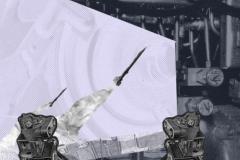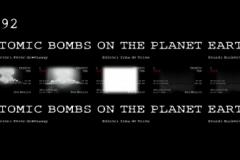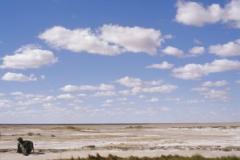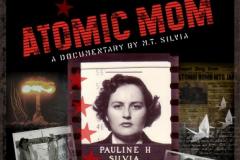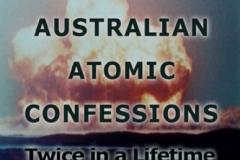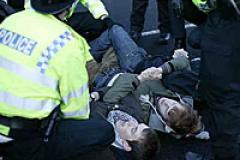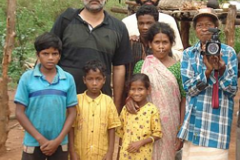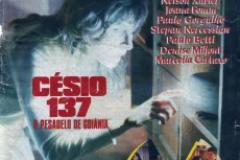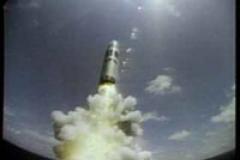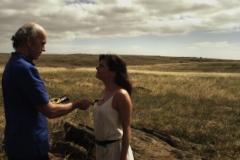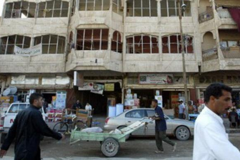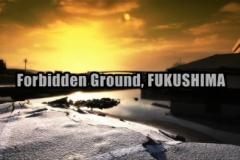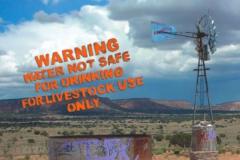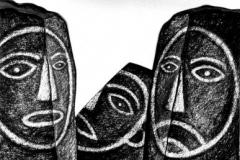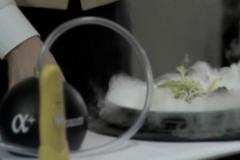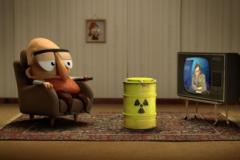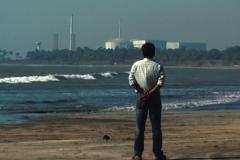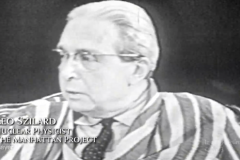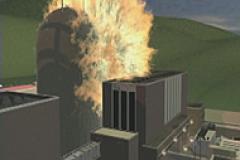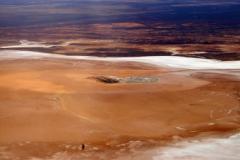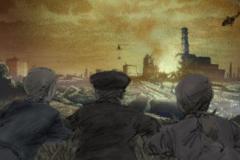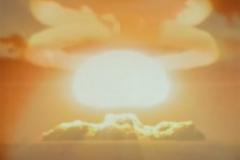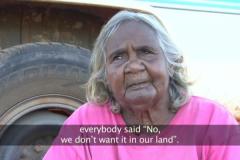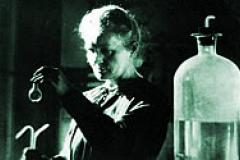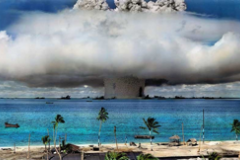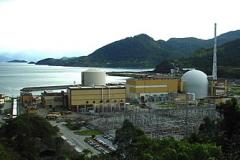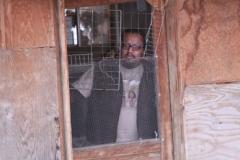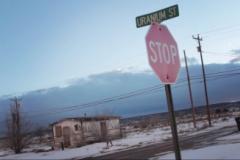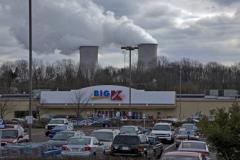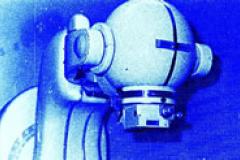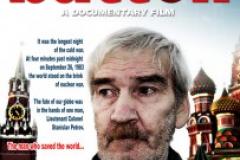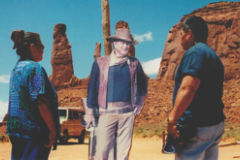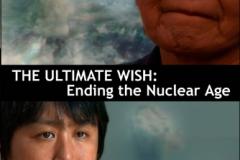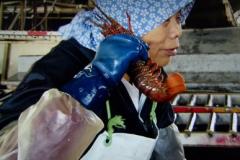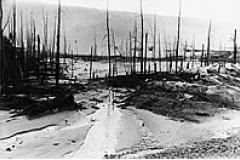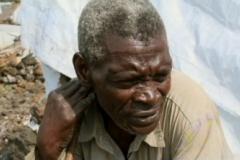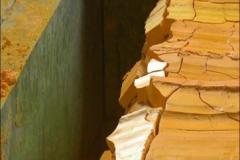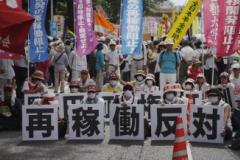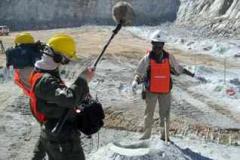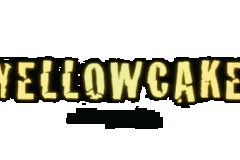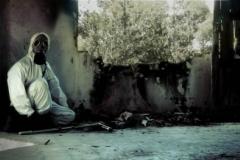WASHINGTON DC & NEW YORK CITY
IUFF USA 2104 - NEW YORK CITY, FEB 14TH TO 19TH
FROM FRI, 14th TO WED, 19th, 2014.
THE INTERNATIONAL URANIUM FILM FESTIVAL IN BROOKLYN - NYC
ART & NUCLEAR AWARENESS: The International Uranium Film Festival comes for the first time to Washington DC and New York, to put under the spotlight Human Rights and the consequences of Nuclear Power, Atomic Bombs, Uranium Mining, Depleted Uranium Weapons.
[nyc-2014]
@ The Pavilion Theater
188 Prospect Park West (bet 14th and 15th st), Brooklyn, NY 11215
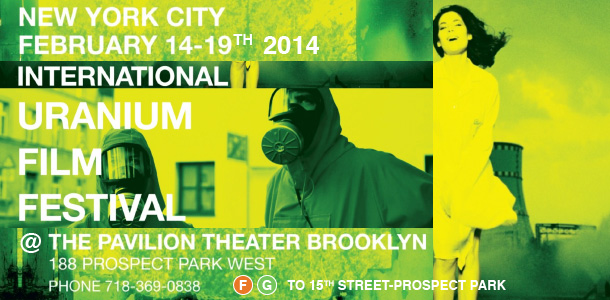
> FESTIVAL PROGRAM & POSTER FOR DOWNLOAD
Argentine/Brazil, 2012, 106 min, Portuguese with English subtitles
Production: O Movimento Falso Filmes
Documentary
The Hibakusha of Brazil. August 6, 1945, at quarter past eight in the morning the USA are dropping the first atomic bomb on the civilian population of the city of Hiroshima. This documentary chronicles the lives of survivors of Hiroshima who are now living in Brazil.came to live in Brazil...
Germany, 2012, 4 min, no dialogue
Animation
World Premiere
Animated short film about Fukushima children who can't play outside. About their dreams and realities.
Bachelor in 2012 of Shoko Hara and Paul Brenner
Sound design and Music: Lorenz Schimpf
Teachers: Prof. Klaus Birk, Alexander Hanowski, Martin Hesselmeier
DHBW Ravensburg, Studiengang Mediendesign
Director Paul Brenner present, Munich 2013
USA, 2011, 6 min, English
Animation/Experimental
Producer: Nathan Meltz
Latin American Premiere
The film remakes a section of the 1983 post-nuclear made-for- TV movie 'The Day After', retelling the story of atomic devastation in a Dada collage-meets-stop-animation style. The film showed atomic bombs reducing humans and animals to skeletons, and a city was blown to rubble.
Brazil, 2002, 4 min, Portuguese
Fiction
One of the first victims of the radioactive accident of Goiânia with Cesium-137 September 1987 was a 6 year old child. Leide das Neves had no time to play.
Royaume-Uni / Pays-Bas | 2011 | 13 min | Documentaire
expérimental / Art Vidéo
Réalisateur : Peter Greenaway.
Conception de la vidéo : Irma de Vries.
Producteur : Changer Performing Arts.
Version originale : multilingue.
www.changeperformingarts.com
Synopsis : Étonnamment, il y a eu 2 201 bombes atomiques larguées sur la planète de 1945 à 1989. Un nombre étonnant de bombes atomiques impliquant d’énormes ravages environnementaux. Le film montre des preuves de chaque explosion documentée : le pays responsable, la date, le lieu, la force et la hauteur au niveau de la terre ou de la mer, et ce, dans une accumulation incessante de destructions à laf ois grandiose et redoutable.
Prix : International Uranium Film Festival. Prix hors concours, Rio de Janeiro 2012.
« Cette réalisation exceptionnelle nous rappelle quelque chose que nous avons tendance à oublier : 2201 bombes atomiques ont été explosé dans ou sur notre propre planète d’origine - qui, du point de vue de la Terre, ne sont pas des tests atomiques du tout, mais des frappes nucléaires préventives.
Greenway a créé une esthétique cinématographique infernale afin de transmettre cette vérité. Utilisant 25 écrans à la fois, Atomic Bombs on Planet Earth, submerge le champ de vision du spectateur avec des cascades éblouissantes de feu poison accentué par les sons de percussion sonique afin
de transmettre l’énorme imprudence des humains face aux nombreuses bombes explosées il n‘y a pas si longtemps. Avant la fin des explosions, Greenway a livré plus de boules de feu qu’aucun spectateur ne serait en mesure d’absorber - et plus que toute planète vivante peut être en mesure de soutenir. L’explosion de la première Trinité apparaît plusieurs fois lorsque Robert Oppenheimer fournit la voix hors champ du film avec des mots répétés comme un mantra : Certains riaient / certains criaient / la plupart restait silencieux. Ce ne sont guère des paroles de sagesse venant du père de la bombe ... et après demi-siècle, en l’absence de sages mots sur les armes nucléaires, nous obtenons ce qui vient à nous : un documentaire expérimental impossible d’oublier qui déclenche dans notre cerveau collectif une migraine atomique de proportions criminellement aliénées dont les énergies vont plus loin et sont destinées à durer plus longtemps que notre propre ADN. » Robert Del Tredici
Australia, 2006, 14 min, English
Documentary
Australia is facing what could be the largest expansion of our nuclear industry ever, with the proposals for increased uranium mining, nuclear power generation and a radioactive waste dump. This film looks at some of the reasons why we must continue to oppose nuclear proliferaton.
(Atomny Ivan)
Russia, 2012, 91 min, Russian, English subtitles
Production: Telesto Film Company
Romantic Comedy
That is a plane story of people from the future which is getting to be real nowadays. The heroes are beautiful and helpless, but they continue to fight for their own happiness and purport. The story takes place in the town where the nuclear engineer may live in one apartment with his mother, the nuclear engineer and his grand-mother – the pioneer of nuclear industry. The story is really outstanding, it is about Ivan and Tania, Tania is interested in her science carrier and Ivan is not interested in anything, but Tania. The new third hero makes heroes to wake up. A lyrical comedy.
Producer Victoria Gromik present, Munich 2013
Japan/USA, 2010, 80 min, English, English subtitles
Documentary
Atomic Mom weaves an intimate portrait of a complex mother-daughter relationship within an obscure moment in American history. Pauline Silvia, the filmmaker's mother, undergoes a crisis of conscience about her work in the military during the early 1950's Atomic Testing Program.
The film follows these mothers, each on a different end of atomic warfare, as they attempt to understand the other.
Australia, 2005, 49 min, English and Aboriginal Australian
Documentary
Latin American Premiere
Sacrificial lambs to the slaughter. Eyewitnesses tell the true story of what happend during the 12 British atomic bomb tests in Australia. The film is a chilling expose of nuclear testing and the demaging legacy that continues these day.
United Kingdom, 2010, 71 min, English
Directors and Producers: Meera Patel and Wolfgang Matt
Production: Maddmovies
Documentary
A story about the biggest weapons of mass destruction ever created, the people who use them and, more importantly, the people who fight them. 'Beating the Bomb' charts the history of the British peace movement against the backdrop of the atomic age. The film also frames the nuclear weapons issue within the wider context of global justice.Beating the Bomb, United Kingdom, 2010, 71 min.
www.beatingthebomb.com, contact: maddmovies@gmail.com
"Beating the Bomb" was selected by the Uranium Film Festival Jury as one of the eight best documentaries of the festival.
Best documentary award, Red Rock Film Festival, Utah, USA
Australia, 2005, 62 min, English
Production: Frontline Film Foundation
Documentary
Latin American Premiere
Blowin' in the Wind examines the secret treaty that allows the US military to train and test its weaponry on Australian soil. It looks at the impact of recycled uranium weapons and the far-reaching physical and moral effects on every Australian. The film's release has been timely as the government currently moves to approve more uranium mines while arguing the contrary - that by going nuclear we are being both 'safe' and 'green'. The film reveals that Iraqi babies are now being born with major birth defects. Bradbury wonders whether Australians living downwind from the military testing ranges will be next. He argues that we were lied to by the British over the Woomera and Maralinga atomic tests. Can we trust another equally powerful partner in our 'war on terror'?
With a cash budget of just $12,000 the film raises pertinent questions which cannot be ignored by the Australian public. The film shocked, angered and surprised large audiences when shown at the Sydney and Brisbane Film Festivals.
www.frontlinefilms.com.au/videos/blowin.htm
(Ragi Kana Ko Bonga Buru)
India, 1999, 52 min, English
Documentary
Not part of the Competition
"Buddha Weeps in Jadugoda" is a documentary film on uranium mining and its deadly impacts on the tribal people living near the Jadugoda mine, mill and tailings dam, in the East Singhbhum district of Jharkhand (India). Unsafe mining, milling and tailings management by UCIL in this area for almost 30 years has resulted in excessive radiation, contamination of water, land and air, destruction of the local ecology, and lead for to genetic mutation, and slow death for the people of the region. The film attempts to depict the gross misuse of power by the authorities in displacing the original inhabitants of the region, the utter lack of concern for internationally accepted norms and safety precautions in the handling of uranium and its by-products, and their callousness of its disastrous impact on the people and the region.
Director Shri Prakash present, Berlin 2012
Q&A with Shriprakash + RAOUF DABBAS, Amman 2014
Brazil, 1989, 95 min, Portuguese, English subtitles
Producer: Laura Pires
Doc Fiction
AUDIENCE AWARD BEST FEATURE FILM 2011
In the ruins of a demolished hospital for cancer treatment in the centre of the Brazilian city Goiânia, two young men found an old "forgotten" Teletherapy Unit, which contained a highly radioactive "Caesium 137 bomb". They sold it to a local scrap metal dealer, who opened that Pandora's box. People were fascinated by the dazzling blue light of the caesium crystals. But they did not know, that it was the shine of the death. Hundreds if not thousands of the citizens and visitors of Goiânia became victims of Caesium 137. The script of the movie is based on statements by the victims and medical personal attending the victims, taken by Roberto Pires at the time of the accident.
(Verstrahlt und vergessen, Tschernobyl und die Folgen)
Germany, 2006, 59 min, German/ Russian, English Subtitle
Production: ARTE – WDR
Brazilian Premiere
April 26th 1986. The day a nightmare scenario became horrific reality: the day reactor block 4 of the Chernobyl atomic power station exploded. While researching and filming this project filmmaker Christoph Boekel met numerous victims of the atomic catastrophe. His own wife was one them and she, too, died of cancer. A moving film told from the personal perspective of the director, it is a requiem for the often forgotten victims of the disaster and a caveat against putting blind trust in technological advancement.
Estonia, 2012, 14 min, without dialog
Comedy Thriller
Producer: Tallinn University Baltic Film and Media School; Estonian Academy of Arts
"What would happen if I gave some of my dad's nuclear liquids to my pet rat?" the kid thought as he poured some uranium into his rat's bowl. BANG!! Curiosity Kills is a splatter comedy about a radioactive killer rat.
USA, 1991, 29 min
Documentary
The documentary uncovers the disastrous health and environmental side effects caused by the production of nuclear materials by the General Electric Corporation. The film juxtaposes GE's rosy "We Bring Good Things to Life" commercials with the true stories of people whose lives were devastated by the company's involvement in testing and making nuclear weapons. Driven by intensely personal testimony and painstaking research, "Deadly Deception" exposes what GE never wanted its customers to know: a shocking pattern of negligence and misinformation spanning several decades. Nine months after this film won the Oscar®, GE pulled out of its work in the nuclear weapons industry, and Corporate Accountability International organizers of the GE boycott, declared victory in their grassroots campaign. The 1991 Academy Award®- winner for Best Short Documentary, Deadly Deception unco-vers the disastrous health and environmental side effects caused by the production of nuclear materials by the General Electric Corporation. The film juxtaposes GE's rosy "We Bring Good Things to Life" commercials with the true stories of people whose lives were devastated by the company's involvement in testing and making nuclear weapons.
Contact: www.groundspark.org
Australia, 2012, 87 min, English
Producer: Tom Young
Science fiction
World Premiere
In the not too distant future, the newly formed Independent Republic of South Australia is the phoenix that rises from the ashes of a decaying and corrupt Australian Commonwealth, becoming wealthy beyond imagination on the back of uranium. However, the real power lies with Double Happiness Uranium, a massive global energy corporation secretly developing the ultimate weapon, a neutron bomb that targets the biological cells of select individuals.
Spain, 2011, 13 min, English
Fiction
A man breaks into an apartment carrying a big black backpack. He is wearing an anti radiation suit. The place looks abandoned the radiation levels are crazy high. Then he looks around and starts searching for things to steal. Soon he will realize he is not alone.
What happens inside an exclusion zone where no one is supposed to be? Is there any people left? If that's the case, are they suffering? This short is meant to answer all those questions.
Irak / France | 2011 | 48 min | Documentaire
Réalisateur: Feurat Alani | Producteur: Baozi
Version originale : Anglais and français
En 2004, Fallujah en Irak est devenu le théâtre d’une confrontation majeure entre l’armée irakienne et les insurgés américains. Mais ce que l’on utilise dans cette guerre américaine est secret. Quel genre d’armes est utilisé? Pour l’instant et depuis 2005, des bébés
déformés naissent. Que s’est-il réellement passé à Fallujah? L’uranium appauvri est-elle la cause des problèmes de santé?
Site du film : http://www.baoziprod.com/New/?p=3440
Réalisateur's Blog: http://feuratalani.blogspot.com.br
Prix
Investigation award and Remand Center Award in Grand Scoop Festival in Lille, 2011
Freedom and human rights Award in Al Jazeera Festival in Qatar in April 2012
International Committee of the Red Cross Award in Monte-Carlo’s Festival in June 2012
Public Award and Jury Award in Khouribga Documentaire Film Festival (Morocco), 2012
USA, 2012, 18 min, Japanese/English, English subtitles
Producer: Yoko Kumano
Documentary
World Premiere
The film addresses the isue of radiation in food after the March 11, 2011, Fukushima desaster. The film features interviews with food producers, restaurant owners and new parents about the food consumption has changed after the nuclear accident and the contamination of the food chain with radioactive elements.
(Gere Dan)
India, 2014, 48 min, French/English with English subtitle
World premier in NewYork City
Niger, Gabon, Congo and other African countries had been going through the experience of Uranium mining since decades. But now more and more Uranium mining companies are going to Africa more aggressively. Poverty, lack of governance and political instability has made this area as heaven for these mining companies. This film is trying to looking from inside of a tiny village 'Falea' in Mali where drilling for prospecting of uranium is going on, and same time also try to see the multiple dimensions of the uranium mining and vested interests of world powers in that same sub-Sahara region.
Both filmmakers are present (New York 2014).
Japan, 2012, 57 min, Japanese, English subtitles
Documentary
World Premiere
It is a documentary on the aftermath of the disaster in Fukushima.
Someone said "Fukushima, it's like a parallel world". It's another world. Apparently, from the outside, everything looks normal. Outside the exclusion zone of 20km, life continues as before, but not quite, this is only an appearance. The danger is invisible. My challenge is: how to make visible what is invisible.
États-Unis | 2012 | 37 min | Documentaire,
Réalisateurs: Deborah Begel et David Lindblom, Executive | Producteurs:
Dr. Johnnye Lewis et Chris Shuey.
Version originale : Navajo & anglais | Sous-titres : anglais Ce documentaire est une méditation en quatre parties sur les problèmes du peuple Navajo avec l’eau potable contaminée. Près d’une personne sur trois de la nation Navajo lutte sur cette question.
Quatre articles sur l’eau débutent avec une multitude de gens qui révèlent l’ampleur des problèmes de contamination de l’eau sur les terres Navajo, des problèmes de santé qui ont probablement été causés par les résidus d’uranium laissé sur l’eau comme «un élément
spirituel» au fait que 30% des Navajo n’ont pas accès à l’eau potable.
États-Unis | 1997 | 9 min | Animation
Réalisateur: Karen AQUA (1954 - May 30th, 2011) /
Musique par Ken Field
Version originale : Aucun dialogue
Synopsis : Dans le sud du centre du Nouveau-Mexique, un ancien site d’art rupestre amérindien est situé à 35 miles du site de l’explosion de la première bombe atomique de l’histoire. La juxtaposition de ces deux sites apporte un contraste frappant entre les deux mondes qui les ont créés ; celui qui vénère et vit en harmonie avec le monde naturel, et qui, en s’efforçant de contrôler les forces de la nature, a créé, une arme pour sa destruction.
Le site Web de Réalisateur : http://karenaqua.com
Prix
Humboldt International Film Festival, CA, 1998: 1st Prize, Animation
Marin County National Festival of Short Films, CA, 1998: 1st Prize, Animation
Green Extreme Film Festival, Canada, 1999: Best Environmental Film
Prix Leonardo, Italy, 1999: Gold Certificate
International Uranium Film Festival SPECIAL ACHIEVEMENT AWARD 2012
(Halbwertszeit)
Germany, 2012, 20min, English subtitles
Production: Bauhaus-University Weimar
Science fiction
In the year 2022: After a serious meltdown in a German nuclear power plant the soil is contaminated and people live in constant threat of radioactive fallout. Low radiation vegetables are so precious that they can be proffered only in fine restaurants. Those can be ordered by the mysterious "Black Card".
So imagine how satirically: A story of a future where the food comes before morality.
(Herr Hoppe und der Atommüll)
Germany, 2011, 4 min
Producer Filmakademie Baden – Württemberg
Animation
A barrel of nuclear waste drops into the living room of Herr Hoppe an average suburbian German. He has to get rid of it and does it in his own wacky way.
USA, 2012, 54 min, English
Documentary with animation
This film is inspired to bring awareness to the Hiroshima and Nagasaki bombings in hopes that a nuclear tragedy like this will never happen again. "Hibakusha" is a Japanese term which refers to a survivor of the atomic bombing of Hiroshima and Nagasaki. The film was built around the story of Kaz Suyeishi, an 84-year-old survivor, who recalls her memories as an 18-year-old Japanese American student when the atomic bomb was dropped on her hometown of Hiroshima. Not only is the story compelling, but so is the form. Well into the project Steve Nguyen decided it shouldn't be a documentary with talking heads, it needed elements to bring to life the emotion of the time. And so the animated documentary was born, taking Kaz's memories and transforming them into animated reenactments. Steve Nguyen, who signed in from Los Angeles and Choz, from New York, began their creative collaboration in 2010 when Steve sought Choz out after hearing praise for his work as a director, including his work on two videos for the Far East Movement.
TRAILER
www.hibakushafilm.com
(Hibakusha - Unser Leben zu Leben)
USA, 2010, 78 min, English with German subtitles.
Memory Productions
Documentary
The stories of Japanese, Korean, and American Hibakusha: Survivers of the atomicbombs. Their stories are linked to the relationship between Eiji Nakanishi (one of youngest survivors of Hiroshima) and his little friend, Yoko, an eight year old girl he teaches to play the guitar. Little by little she learns about Eiji's hiba-kusha experience. She becomes intrigued by colorful pictures and drawings made by the survivors. Then she discovers Sadako and the story of the Thousand Cranes. "Will Eiji take me to thePeace Festival in Hiroshima?" The bombing of Nagasaki is shown through the sharp focus of a Shinto wedding ceremony. Back in America, Davey throws down his tin pot and wooden spoon of his Hiroshima-Nagasaki celebrations.
Inde | 2013 | 27 min | Documentaire
Réalisateur: Pradeep Indulkar
Version originale : Marathi/anglais | Sous-titres: Anglais,
allemand, français
Synopsis : Tarapur Nuclear Power Project est le premier établissement nucléaire civil de l’Inde mis en place il y a environ 50 ans déplaçant certains villages près de la ville de Tarapur. Un jour un protagoniste visite ces villages (Dandi, Pofaran, Ghivali, Unbhat et Tarapur) après 40 longues années. Il observe la situation des milliers de personnes déplacées. Il découvre que la plupart des gens ont perdu leurs emplois traditionnels et n’ont pas retrouvé de nouveaux emplois, ils ont perdu leurs terres, maisons et la mer et ils n’ont pas obtenu aucune compensation adéquate ni aucun service promis (infrastructures comme les routes, l’eau, l’électricité, les installations médicales, écoles, etc.) Au lieu de cela ils sont malades et ont des maladies inconnues. Des problèmes de reins et mortinatalité et les cas d’accouchement avec complications ont augmenté. Les enfants de moins de 5 ans souffrent de troubles mentaux. Le coût réel de l’énergie est payé par ces personnes inconnues et innocentes.
Site du film : http://highpowerdoc.webs.com/apps/links/
Film: https://www.youtube.com/watch?v=MczgOcNnDk8
Prix
YELLOW OSCAR, Best Short Documentaire, International Uranium Film Festival Rio 2013
Japon | 88 minute 40 | 2009 | Documentaire.
Réalisateur : Takashi Itoh | Producteur : Takashi Itoh.
Version originale : Japonaise et coréenne | Soustitres: anglais.
Est-ce que l’expérience de la bombe atomique chez la jeune génération de japonais peut vraiment être comprise? Comment ce souvenir peut rester en vie pour la génération à venir? En descendant la côte ouest-américaine, visitant 18 survivants de la bombe atomique ainsi qu’un survivant de l’holocauste,
deux jeunes Japonais sont témoins des moments les plus intimes de leur vie et se voient révéler la nature cruelle des cicatrices psychologiques. Avec le vaste paysage de l’Ouest américain en arrièrefond, les deux réfléchissent sur leur relation à l’histoire contemporaine du Japon. Le réalisateur Shinpei
Takeda a suivi les survivants des bombardements atomiques en Amérique du Nord et du Sud pendant les 5 dernières années. Site du film : http://www.shinpeitakeda.info/2012/01/23/hiroshima-nagasakidownload/
Prix
SPECIAL ACHIEVEMENT AWARD, International Uranium Film Festival, Rio 2013
EUA, 2011, 109 min, inglês, legendas em espanhol
Documentário
Classificação indicativa 12
Filme monumental sobre o mundo armado com bombas atômicas: um retrato da Era Nuclear e da Guerra Fria, com cenas históricas dos EUA, Europa e Japão.
USA, 2003, 29 min, English
Documentary
Latin American Premiere
Shows the impossibility of evacuation at Indian Point nuclear power plant outside NY City. Produced after the 9/11 terror attack on New York City and the terrorists announced they had targeted the Indian Point Nuclerar Power station but decided to fly by it to the Twin Towers instead.
Tobe Carey will attend the screening (New York, 2014).
Australia, 2012, 15 min, English subtitles
Production: Curtis Taylor & Eleanor Winkler
Currently the international mining company Cameco are conducting Uranium exploration in Kintyre, a remote part of the Western Desert in Western Australia. The traditional owners of the land, the Martu are currently in negotiation with Cameco over the future of their traditional country and are torn over issues of environmental conservation and financial prosperity. In 2011, Cameco arranged for a delegation of Martu community elders to travel to an established uranium mine at Rabbit Lake in Canada, which is situated in 1st Nation territory. A cultural exchange occurs between the 1st Nation and the Martu and as many questions as answers are sparked from the trip to Rabbit Lake.
Germany / Ukraine, 2011, 19 min, Russian, English Subtitles
Animated documentary
Producer: Tetyana Chernyavska
Yellow Oscar Best Animation Film 2012
A Soviet family searching for a modest paradise is swept into an immense disaster. This magically animated film combines drawing, photography and documentary video to capture the surreal emotions of the too-real tragedy: Chernobyl 1986.
Israel, 2012, 3 min, without dialog
Experimental
The video includes footages from authentic shots of bombing, from popular American movies and from propaganda movies that was created by the American government during the "cold war". The footages were edited in a technique that reminds the Photomontage that was used in photography in the end of the 19th century and in the Film-making between the two world-wars. The Photomontage brings up questions of reality and fiction and deals with the zone of ethics and aesthetics.
Australia, 2010, 10 min
Documentary
Muckaty Voices is a short film capturing Aboriginal community resistance to an Australian government plan to dump low and long lived intermediate level radioactive waste at Muckaty Station, 120km north of Tennant Creek in the Northern Territory. The government's push for Muckaty has sparked widespread criticism from the targeted community, trade unions, national health and environment groups and Indigenous organizations. A federal court challenge has been launched to contest the Muckaty nomination. The film presents the country and community affected by this proposal.
The film was produced for the Muckaty Traditional Owners by Enlightning Productions, with support of Beyond Nuclear Initiative: www.beyondnuclearinitiative.com
USA, 2010, 73 min, English
Documentary
Latin American Premiere
Yellow Oscar Best Feature Film 2012
For much of the twentieth century the United States Department of Defense was a major producer of radioactive waste. The Pentagon not only produced its own nuclear waste. For years, the Pentagon depended on an unknown number of private defense contractors to supply countless radioactive parts and equipment. In the mid-twentieth century, the U.S. government actually gave some of these defense contractors permission to dump radioactive waste on their private properties.
The Pentagon seldom, if ever, disclosed the whereabouts of these dangerous nuclear dumps. The problem becomes one for the ages: many of these radioactive isotopes remain dangerous and "hot" for thousands of years, even as the radiation is invisible to unsuspecting victims.
This carelessness caught up with college students in Lock Haven, Pennsylvania. One day the students woke up to find environmental officials dressed in protective "moonsuits" searching their apartment building for tell-tale signs of radioactive waste.
États-Unis | 2012 | 87 min, Documentaire.
Réalisateur : Adam Jonas Horowitz.
Version originale : Anglaise | Sous-titres: français.
Issu de documents récemment déclassifiés du gouvernement américain, ce documentaire présente le témoignage des survivants, et des images d’archives jamais vues. Nuclear Savage découvre l’un des chapitres les plus troublants de l’histoire américaine moderne ; comment les habitants des îles Marshall, considérés comme une culture civilisée, ont été délibérément utilisés comme cobayes humains pour étudier les effets des retombées nucléaires. Entre 1946 et 1958 les États-Unis ont testé 67 armes nucléaires au-dessus du sol, sur ou près des îles Bikini et Enewetok atolls. La bombe à hydrogène est 1000 fois plus puissante que la bombe d’Hiroshima. Des Îles entières ont été vaporisées et les îles habitées ont été recouvertes par les retombées. Les gens fortement exposés de Rongelap ont ensuite été inscrits comme des sujets humains dans le top-secret Project 4.1 et évacués vers une île fortement contaminée pour étudier les effets de la consommation d’aliments radioactifs pendant près de 30 ans. Beaucoup d’habitants des îles Marshall ont développé des cancers et ont eu des enfants qui étaient mort-nés ou avec des malformations congénitales graves.
Nuclear Savage suit les insulaires dans leur lutte pour la justice et la reconnaissance de ce qui leurs a été fait. Malgré les récentes révélations, le gouvernement américain continue de nier que les insulaires ont été délibérément utilisés comme cobayes humains. Le film soulève des questions troublantes sur le racisme, l’obligation morale du gouvernement américain pour les habitants des îles Marshall, et pour quelle raison le gouvernement continue de cacher les tests du Project 4.1 après plusieurs décennies.
Prix
AUDIENCE AWARD, Best Film Cinema Planeta International Festival, Mexico
JURY PRIZE, Best Feature Documentaire, Paris/FIFE International Festival of Environmental Films
JURY PRIZE, Chicago Peace on Earth Film Festival
YELLOW OSCAR, Best Feature Documentaire, International Uranium Film Festival Rio 2013
(Pedra Podre)
Brazil, 1990, 26 min, Portuguese with English subtitles
Documentary
It is the first Documentary made about the Brazil's nuclear power plants, Angra 1 and Angra 2 in the Atlantic Rainforest region in the South of Rio de Janeiro. With ironic humor, it shows that the official safety and evacuation plans to protect the local population and tourists in case of a nuclear meltdown are just a joke. Worse: Angra 1 and 2 are constructed on a beach, which the indigenous population (Guarani-Mbyá) called once Itaorna: Rotten Rock.
USA, 2011, 30 min, English
Producer: Yvonne Latty
Documentary
Latin American Premiere
"Sacred Poison" is a 30-minute documentary that brings viewers into the pain and devastation that uranium mining brought into the lives of too many Navajo. It is a moving documentary whose power is in the voices and the people that we meet. It is raw and intimate, and I use what I learned from years of reporting, my journalism, to bring their stories to life. The usually reserved Navajo reveal the pain and struggle of living life where the amount of clean water you have to drink is very limited, where one family lost seven children to uranium contamination, where various forms of cancer seem to live inside so many neighbors.
TRAILER
http://sacredpoison.com
USA, 2011, 17 min, English subtitles
Experimental
Twelve fictional time-travelers explore the post-atomic age American West, when they discovered the abandoned tunnels beneath Yucca Mountain Radioactive Waste Repository, in this sixteen-minute long Experimental SciFiction Punk Western.
USA, 2012, 12 min, English
Documentary
Just outside Grants, New Mexico, is a 200-acre heap of toxic uranium waste, known as tailings. After 30 years of failed cleanup, the waste has deeply contaminated the air and water near the former uranium capital of the world. TAILINGS is a cinematic investigation into the pile that is gravely shaping the lives of those who are stuck living in its shadow.
TRAILER: http://tailingsfilm.com
TAILINGS won the Best New Mexico Short Award of the Santa Fe Independent Film Festival.
USA, 2011, 92 min, English
In 2010, the United States announced the first new nuclear power plant construction in over 32 years. The "Nuclear Renaissance" was born, and American's long stared expasion of nuclear energy was infused with new life.
Iran, 2013, 6 min, without dialog
Animated fiction
Special Achievement Award 2013
A world war had been destroyed the entire civilization. Everybody is wondering around lost, neglecting each other. Until one day a young girl finds the last flower on earth. Excited from her discovery she runs to people to tell them about the flower, but people do not care. At last a young man shows interest to the story. Together they take care of the flower and fall in love. With love, the entire planet grow and people begin to build civilization again. Meanwhile the war machine factories appear and the story of war begin again...
(O Pesadelo é Azul)
Brazil, 2008, 24 min, Portuguese/German, English subtitles
In 1987 in Goiânia took place one of the biggest radioactive accidents of the world. Twenty years later the survivers are telling what happened and about their live after the accident. The short film won the Award as best documentary of the 6thABD Cine Goiás Festival (Troféu Pedra Goiâna) 2008.
USA/Singapore, 2010, 2 min, English
Production: Angela How, Morgan Faye
Fiction
Latin American Premiere
A family sits down to a delicous dinner ... or do they? The "Nuclear" Family is a short commercial spec made for the 2010 Swackhamer video contest. The contest topic is:
Shortly after nuclear weapons were first invented, Albert Einstein stated: "The unleashed power of the atom has changed everything save our modes of thinking and we thus drift toward unparalleled catastrophe.
Poland/USA, 2011, 52 min, Russian, English subtitles
Production: Miroslaw Grubek, Slawomir Grunberg
Documentary
Yellow Oscar Nomination
The Red Button is a 52-minute documentary film that tells the dramatic story of Stanislav Petrov, the Russian officer who, in 1983, saved the world from atomic war.
During the early '80s, the Russian leader was Jurij Andropov, the most right-wing Soviet leader since Stalin. A known hardliner, Andropov was very wary of US activity. It was an intense period of time in the relationship between the United States and Russia. Tensions were running high between the two superpowers, and the atmosphere was suspicious because of recent incidents. On September 5th, a Korean jet liner with 269 passengers, many of whom were American, had been shot down over Soviet territory because the Russians believed it was a spy mission. The action led Reagan to label Russia an "evil empire." Soon after, the KGB communicated to the western operatives to prepare for possible nuclear war. It is now thought that throughout 1983, the Kremlin assumed that the US and its allies were planning a nuclear strike on the Soviet Union.
So it was in this tense environment that Stanislav Petrov worked deep inside Serpukhov-15, a secret bunker, monitoring early warning satellites. On September 26, 1983, Pietrow was in charge of monitoring American missiles that could potentially be sent to Russia to start a nuclear war. It was not his normal duty; he was to man the post twice a month just to keep his skills from getting rusty. Shortly after midnight, Petrov noticed a missile on his screen. Thinking it was a possible error, he nervously ignored it and waited for any other indications of war. Several minutes later, things became much more serious: four more missiles appeared and a flashing red warning sign began asking him to confirm an incoming attack. By pressing the red button, Petrov would have sent the information up the chain of command to Jurij Votincev, the Commander in Chief of the Russian missile defense, and then to Jurij Andropov who was in charge of the new "nuclear suitcase" and who would have undoubtedly called for a counterattack.
Petrov knew he only had about fifteen minutes to decide what he would do before the missiles would reach the Soviet Union. If he didn't pass the information along, Petrov would be ignoring orders and taking responsibility into his own hands. The protocol, which Petrov had written himself, clearly indicated that the correct course of action would be to inform the Commander in Chief. 120 panicked military officers and engineers sat behind him, looking at the screen and waiting for his decision. "Everyone jumped from their seats looking at me," says Petrov. "What could I do? There was a procedure that I had written myself." The future of the world was in the 44-year-old Russian officer's hands as he wrestled with the decision of whether or not to use Russia's atomic button. In a bold move, however, Petrov decided against it, blaming the signals on faulty equipment instead of imperialistic aggression. At the time, he was not sure he had made the right choice.
Fortunately for all of us, Petrov made the correct decision. His reasoning was that if the Americans were going to start an atomic war, they would have sent hundreds of missiles, not just five.
États-Unis | 2000-2008 | 57 minutes | Documentaire.
Réalisateur : Jeff Spitz | Producteur : Jeff Spitz et Bennie Klain. Version originale : Anglaise | Sous-titres: français.
Le film raconte une chaîne d’événements extraordinaires, en commençant par l’apparition d’une bobine de film des années 1950, qui conduit au retour d’un frère perdu depuis longtemps, à sa famille Navajo. Vivant depuis plus de six décennies à Monument Valley (sur la frontière de l’Arizona / Utah), la famille Cly a une histoire extraordinaire en images. Depuis 1930 les membres de la famille sont apparus comme des sujets non identifiés dans d’innombrables photographies et films tournés à Monument Valley, y compris diverses cartes postales, les Westerns d’Hollywood et le rare film produit à la maison par le légendaire réalisateur John Ford.
Mais c’est l’apparition soudaine d’un film rarement vu qui affecte le plus leur vie. Avec le retour de «Navajo Boy», Elsie saisit l’occasion de raconter l’histoire de sa famille pour la première fois, offrant une perspective unique à l’histoire de l’Ouest américain. En utilisant une variété de photos fixes et images
en mouvement des années 40 et 50 et racontant dans leurs propres mots l’histoire de leur famille, les Cly font la lumière sur l’origine de la photographie et l’exploitation minière de l’uranium à Monument Valley. The Return of Navajo Boy & Epilogue, une sélection officielle du Festival du Film de Sundance et PBS, est un
documentaire de renommée internationale qui a réuni une famille Navajo et a déclenché une enquête fédérale sur la contamination de l’uranium. Il raconte l’histoire d’Elsie Mae Begay, dont l’histoire en images révèle une lutte incroyable et continue pour la justice environnementale.
Un nouvel épilogue puissant (produit en 2008) montre comment le film et la campagne de sensibilisation de Groundswell Educational Films’ créent des nouvelles et rallient des partisans y compris le membre du Congrès Henry Waxman (D-CA). Le président de la commission de surveillance et de réforme du gouvernement a mandaté un plan de nettoyage par les cinq agences qui sont responsables de la contamination de l’uranium. Depuis que le film a été réalisé, Bernie Cly, une de la famille Navajo vedette, a reçu $ 100 000 en compensation du gouvernement américain.
Site du film : www.navajoboy.com
Prix
2000, Best Documentary, Indian Summer Festival
2000, Programmer’s Choice Award, Planet in Focus Film Festival, Canada
2000, Audience Award, Durango International Film Festival
2000, Official Selection, Sundance Film Festival
USA, 2012,40 min, English/Japanese/French, English subtitles
Co-production Kathleen Sullivan
Documentary
Moving, unforgettable living witnesses who survived two of the world's most momentous radiation crises: Nagasaki in 1945 and Fukushima in 2011.
They are interlaced with nuclear experts and archival footage, some shocking, illuminating the largely unrecognized connection between nuclear weapons and nuclear power, and the growing global movements to abolish both.
The documentary is both a tragic and an inspirational example of courageous women in the face of environmental catastrophes and an alert to everyone today about the dangers of continued nuclear proliferation and nuclear power.
http://richtervideos.com/TheUltimateWish/
Director will be present (New York 2014)
(Der Bauch von Tokyo)
Germany, 2013, 70 min, English subtitles
Producer: Defi-Filmproduktion
World Premiere
A film guide to understanding Japan – before and after the atomic catastrophe of Fukushima.
I lived in Tokyo for two years. Every day, I looked out the window of my high-rise apartment onto an endless sea of buildings. I was living in the world's largest city – together with 36 million people. Since the 11th of March 2011, the perspective has shifted. A film about how Tokyo is serviced and supplied, which is also a study in mentality, must necessarily make reference to a triple disaster.
In July 2012, I went back to visit the same fishmongers, bio-farmers, and sanitation workers in Tokyo and in northeast Japan, and I asked them how things had changed.
They gave impressive accounts of what they'd experienced since the spring of 2012 and talked openly about their fears and concerns, which still haunt them today.
They talked about the spread of false information about Fukushima, about withheld reports of water and sewage contamination, and about manipulated media coverage of demonstrations and other acts of civil disobedience.
Director Reinhild Dettmer-Finke present, Munich 2013
Special Achievement Award
Canada | 1990 | 48 minutes | Documentaire.
Réalisateur : Magnus Isacsson (1948 - 2012).
Producteur : Office national du film du Canada.
Version originale : Anglaise.
Synopsis : Ce film expose les problèmes éthiques et environnementaux qui entourent la pratique de l’extraction de l’uranium au Canada. Le film présente des faits percutants et peu connus sur les effets néfastes de l’exploitation minière de l’uranium sur l’environnement ainsi que sur la santé de ceux qui travaillent dans l’industrie. Les déchets toxiques radioactifs sont un sous-produit très dommageable de l’exploitation minière de l’uranium. Il a été prouvé qu’ils causent des dommages environnementaux à long terme. Les mêmes déchets radioactifs exposent les mineurs à des risques extrêmes de développer des cancers. Enfin, parce que la plupart des industries minières à ce jour ont été établies sur des terres historiquement occupées par les populations autochtones du Canada, l’exploitation minière de l’uranium viole la vie économique, spirituelle et traditionnelle de nombreux peuples des premières nations.
Site web du film : www.socialdoc.net/magnus et remorque : https://www.nfb.ca/film/uranium
Prix
Golden Sheaf Award at the Yorkton Film Festival in 1991
(Hazman Hatzahov)
Israel, 2012, 54 min, English subtitles
Production Sasha Klein Production
World Premiere, Rio 2013
With unparalleled bravery, journalist Shanny Hazzia goes behind the scenes of one of the most dangerous black markets in the world. In an attempt to unravel some of the mystery behind the uranium trade, she travels to Congo where her rare documentation allows a peak into the shady dealings of “the yellow market”. Congo is a conflict ridden country where many regions are controlled by militias. With little or no supervision the main victims become the villagers who live near the uranium mines. A powerful piece of journalism that takes on a very hot topic.
Contact
Cara Saposnik
Ruth Diskin Films
Festivals and Marketing
www.ruthfilms.com
France | 52 min | Documentaire
Réalisateur: Dominique Hennequin / Producteur:
Nomades TV
Français and Anglais
Synopsis : Une enquête choquante dans les mines d’uranium en Afrique. Nous visitons trois zones touchées par l’industrie de l’uranium; Mounana où l’activité a cessé. Arlit, où les mines ont été actives depuis 40 ans, et d’Imouraren, un futur site. Géant de l’énergie française, la compagnie Areva est sortie de
Mounana, au Gabon, en 1999. La mine d’uranium Comuf a été fermée et recouverte. En fait, d’un coup d’oeil, c’est presque comme si la mine n’avait jamais existé. Cependant, Mounana souffre d’un niveau extrêmement dangereux de pollution radioactive. Le sol et les rivières sont toxiques; même les maisons ont un compteur Geiger huit fois plus élevé que la limite de sécurité. Ces maisons ont été construites en utilisant des matières radioactives.
Site web du film : http://www.javafilms.fr/spip.php?article311
À Arlit, au nord du Niger, nous rencontrons des problèmes similaires, y compris un nombre anormalement élevé de cancers du poumon. Maintenant que la compagnie Areva a quitté, les anciens mineurs doivent payer pour leurs propres soins de santé. En dépit des affreux dommages causés aux populations locales sur les sites précédents, une autre mine est en construction, en Imouraren. Le résultat d’un accord colossal entre les gouvernements de la France et du Niger, ce sera la plus grande mine à ciel ouvert jamais construite. La compagnie Areva affirme que la nouvelle mine n’empoisonnera pas la terre, mais la population locale est sceptique.
Site du film: http://www.javafilms.fr/spip.php?article311
Japan, 2012, 27 min, English subtitles
Kugi Productions
Documentary
Six Japanese women offer brutally honest views on the state of the clean-up, the cover-ups and untruths since the nuclear accident in Fukushima, and how it has affected their lives, homes and families.
Allemagne | 2010-2014 | 35 minutes (version
courte) | Documentaire.
Directeur : Joachim Tschirner.
Version originale : Anglaise.
Il s’agit d’une nouvelle version courte du long métrage documentaire «Yellow Cake. La saleté derrière l’uranium se concentre sur une mine d’uranium secrète en Allemagne de l’est, qui a produit pendant des décennies des «yellow cake» pour les bombes atomiques de l’Union Soviétique. C’était la troisième plus grande mine
d’uranium dans le monde, situé dans les provinces de Saxe et de Thuringe. Fonctionnant jusqu’à la réunification, elle avait le nom de code WISMUT - allemand de bismuth. Le film raconte l’histoire de la Wismut et accompagne depuis plusieurs années la première opération de nettoyage de l’histoire de l’exploitation minière de l’uranium.
Site web du film : www.yellowcake-derfilm.de
Prix
YELLOW OSCAR, Best Short Documentary, International Uranium Film Festival Rio 2014
Note de Réalisateur - « YELLOW CAKE » est le résultat d’un projet qui a débuté en 2002. « The World Uranium Hearing » a eu lieu il y a plus d’une décennie. La déclaration de cette audience est devenu la signification essentielle de mon film : « La radioactivité ne sait rien des différences culturelles ou les frontières politiques. Et dans un monde muté empoisonné par la radioactivité mortelle, il ne sera plus d’importance, si nous séparons nos déchets, conduisons moins de voitures, utiliser un détergent sans phosphate, ou planter un arbre. Nul importe si nous passons notre temps à essayer de sauver les éléphants. Quelle que soit l’action que nous prenons à ce point serait superflue et dépourvue de sens. C’est pourquoi la fin de l’ère atomique doit commencer par le premier maillon de la chaîne de production nucléaire - L’ extraction de l’uranium « Pendant mes recherches, j’ai fait l’expérience que, malgré son caractère explosif, l’exploitation minière de l’uranium fait rarement dans la sensibilisation du public. Le film « Yellow Cake » est ma réaction à cette situation inacceptable. Joachim Tschirner
USA, 2009, 10 min
Production: Boxcar Films
From Exploration to fuel production, this documentary relates the contamination, water consumption, waste generation, costs to the American taxpayer through government subsidies, health impacts,and the CO2 emissions that are caused by the front end of the nuclear fuel cycle. Each phase has its own devastating impact on the environment and the surrounding population, from socioeconomic to health and safety. This film takes a deeper look into the facts that are, all too often, left unsaid. America is going "Down the Yellowcake Road," but given this information, shouldn't we ask the necessary question: Is this what we really want? This short documentary was created by Boxcar Films in 2009 to explore the frontend of the nuclear fuel production cycle. The short was funded by Colorado Citizens Against Toxic Waste.
www.boxcarfilms.com
Film info: www.downtheyellowcakeroad.org
Spain, 2012, 14 min, English subtitles
Fiction
Premiere in Germany
25 years passed since the disaster in Chernobyl. Since then, the exclusion zone stays closed to the outer world, uninhabited except for a few indomitables. A centenarian secret still stays asleep there and, in each search, a young Ukrainian will travel to the zone, finding along the way the answers he has looked for all his entire life.
IUFF USA 2014 - WASHINGTON DC, FEB 10TH TO 12TH
FROM MON, FEB 10th TO WED, FEB 12th, 2014.
THE INTERNATIONAL URANIUM FILM FESTIVAL IN WASHINGTON DC
ART & NUCLEAR AWARENESS: The International Uranium Film Festival comes for the first time to Washington DC and New York, to put under the spotlight Human Rights and the consequences of Nuclear Power, Atomic Bombs, Uranium Mining, Depleted Uranium Weapons.
@ Goethe-Institut Washington, GoetheForum
812 Seventh Street, NW
Washington, DC 20001-3718, USA
Tel. +1 (202) 289-1200
info@washington.goethe.org
Germany, 2012, 4 min, no dialogue
Animation
World Premiere
Animated short film about Fukushima children who can't play outside. About their dreams and realities.
Bachelor in 2012 of Shoko Hara and Paul Brenner
Sound design and Music: Lorenz Schimpf
Teachers: Prof. Klaus Birk, Alexander Hanowski, Martin Hesselmeier
DHBW Ravensburg, Studiengang Mediendesign
Director Paul Brenner present, Munich 2013
Royaume-Uni / Pays-Bas | 2011 | 13 min | Documentaire
expérimental / Art Vidéo
Réalisateur : Peter Greenaway.
Conception de la vidéo : Irma de Vries.
Producteur : Changer Performing Arts.
Version originale : multilingue.
www.changeperformingarts.com
Synopsis : Étonnamment, il y a eu 2 201 bombes atomiques larguées sur la planète de 1945 à 1989. Un nombre étonnant de bombes atomiques impliquant d’énormes ravages environnementaux. Le film montre des preuves de chaque explosion documentée : le pays responsable, la date, le lieu, la force et la hauteur au niveau de la terre ou de la mer, et ce, dans une accumulation incessante de destructions à laf ois grandiose et redoutable.
Prix : International Uranium Film Festival. Prix hors concours, Rio de Janeiro 2012.
« Cette réalisation exceptionnelle nous rappelle quelque chose que nous avons tendance à oublier : 2201 bombes atomiques ont été explosé dans ou sur notre propre planète d’origine - qui, du point de vue de la Terre, ne sont pas des tests atomiques du tout, mais des frappes nucléaires préventives.
Greenway a créé une esthétique cinématographique infernale afin de transmettre cette vérité. Utilisant 25 écrans à la fois, Atomic Bombs on Planet Earth, submerge le champ de vision du spectateur avec des cascades éblouissantes de feu poison accentué par les sons de percussion sonique afin
de transmettre l’énorme imprudence des humains face aux nombreuses bombes explosées il n‘y a pas si longtemps. Avant la fin des explosions, Greenway a livré plus de boules de feu qu’aucun spectateur ne serait en mesure d’absorber - et plus que toute planète vivante peut être en mesure de soutenir. L’explosion de la première Trinité apparaît plusieurs fois lorsque Robert Oppenheimer fournit la voix hors champ du film avec des mots répétés comme un mantra : Certains riaient / certains criaient / la plupart restait silencieux. Ce ne sont guère des paroles de sagesse venant du père de la bombe ... et après demi-siècle, en l’absence de sages mots sur les armes nucléaires, nous obtenons ce qui vient à nous : un documentaire expérimental impossible d’oublier qui déclenche dans notre cerveau collectif une migraine atomique de proportions criminellement aliénées dont les énergies vont plus loin et sont destinées à durer plus longtemps que notre propre ADN. » Robert Del Tredici
Japan, 2012, 57 min, Japanese, English subtitles
Documentary
World Premiere
It is a documentary on the aftermath of the disaster in Fukushima.
Someone said "Fukushima, it's like a parallel world". It's another world. Apparently, from the outside, everything looks normal. Outside the exclusion zone of 20km, life continues as before, but not quite, this is only an appearance. The danger is invisible. My challenge is: how to make visible what is invisible.
Inde | 2013 | 27 min | Documentaire
Réalisateur: Pradeep Indulkar
Version originale : Marathi/anglais | Sous-titres: Anglais,
allemand, français
Synopsis : Tarapur Nuclear Power Project est le premier établissement nucléaire civil de l’Inde mis en place il y a environ 50 ans déplaçant certains villages près de la ville de Tarapur. Un jour un protagoniste visite ces villages (Dandi, Pofaran, Ghivali, Unbhat et Tarapur) après 40 longues années. Il observe la situation des milliers de personnes déplacées. Il découvre que la plupart des gens ont perdu leurs emplois traditionnels et n’ont pas retrouvé de nouveaux emplois, ils ont perdu leurs terres, maisons et la mer et ils n’ont pas obtenu aucune compensation adéquate ni aucun service promis (infrastructures comme les routes, l’eau, l’électricité, les installations médicales, écoles, etc.) Au lieu de cela ils sont malades et ont des maladies inconnues. Des problèmes de reins et mortinatalité et les cas d’accouchement avec complications ont augmenté. Les enfants de moins de 5 ans souffrent de troubles mentaux. Le coût réel de l’énergie est payé par ces personnes inconnues et innocentes.
Site du film : http://highpowerdoc.webs.com/apps/links/
Film: https://www.youtube.com/watch?v=MczgOcNnDk8
Prix
YELLOW OSCAR, Best Short Documentaire, International Uranium Film Festival Rio 2013
Israel, 2012, 3 min, without dialog
Experimental
The video includes footages from authentic shots of bombing, from popular American movies and from propaganda movies that was created by the American government during the "cold war". The footages were edited in a technique that reminds the Photomontage that was used in photography in the end of the 19th century and in the Film-making between the two world-wars. The Photomontage brings up questions of reality and fiction and deals with the zone of ethics and aesthetics.
États-Unis | 2012 | 87 min, Documentaire.
Réalisateur : Adam Jonas Horowitz.
Version originale : Anglaise | Sous-titres: français.
Issu de documents récemment déclassifiés du gouvernement américain, ce documentaire présente le témoignage des survivants, et des images d’archives jamais vues. Nuclear Savage découvre l’un des chapitres les plus troublants de l’histoire américaine moderne ; comment les habitants des îles Marshall, considérés comme une culture civilisée, ont été délibérément utilisés comme cobayes humains pour étudier les effets des retombées nucléaires. Entre 1946 et 1958 les États-Unis ont testé 67 armes nucléaires au-dessus du sol, sur ou près des îles Bikini et Enewetok atolls. La bombe à hydrogène est 1000 fois plus puissante que la bombe d’Hiroshima. Des Îles entières ont été vaporisées et les îles habitées ont été recouvertes par les retombées. Les gens fortement exposés de Rongelap ont ensuite été inscrits comme des sujets humains dans le top-secret Project 4.1 et évacués vers une île fortement contaminée pour étudier les effets de la consommation d’aliments radioactifs pendant près de 30 ans. Beaucoup d’habitants des îles Marshall ont développé des cancers et ont eu des enfants qui étaient mort-nés ou avec des malformations congénitales graves.
Nuclear Savage suit les insulaires dans leur lutte pour la justice et la reconnaissance de ce qui leurs a été fait. Malgré les récentes révélations, le gouvernement américain continue de nier que les insulaires ont été délibérément utilisés comme cobayes humains. Le film soulève des questions troublantes sur le racisme, l’obligation morale du gouvernement américain pour les habitants des îles Marshall, et pour quelle raison le gouvernement continue de cacher les tests du Project 4.1 après plusieurs décennies.
Prix
AUDIENCE AWARD, Best Film Cinema Planeta International Festival, Mexico
JURY PRIZE, Best Feature Documentaire, Paris/FIFE International Festival of Environmental Films
JURY PRIZE, Chicago Peace on Earth Film Festival
YELLOW OSCAR, Best Feature Documentaire, International Uranium Film Festival Rio 2013
(Pedra Podre)
Brazil, 1990, 26 min, Portuguese with English subtitles
Documentary
It is the first Documentary made about the Brazil's nuclear power plants, Angra 1 and Angra 2 in the Atlantic Rainforest region in the South of Rio de Janeiro. With ironic humor, it shows that the official safety and evacuation plans to protect the local population and tourists in case of a nuclear meltdown are just a joke. Worse: Angra 1 and 2 are constructed on a beach, which the indigenous population (Guarani-Mbyá) called once Itaorna: Rotten Rock.
USA, 2011, 92 min, English
In 2010, the United States announced the first new nuclear power plant construction in over 32 years. The "Nuclear Renaissance" was born, and American's long stared expasion of nuclear energy was infused with new life.
Iran, 2013, 6 min, without dialog
Animated fiction
Special Achievement Award 2013
A world war had been destroyed the entire civilization. Everybody is wondering around lost, neglecting each other. Until one day a young girl finds the last flower on earth. Excited from her discovery she runs to people to tell them about the flower, but people do not care. At last a young man shows interest to the story. Together they take care of the flower and fall in love. With love, the entire planet grow and people begin to build civilization again. Meanwhile the war machine factories appear and the story of war begin again...
Allemagne | 2010-2014 | 35 minutes (version
courte) | Documentaire.
Directeur : Joachim Tschirner.
Version originale : Anglaise.
Il s’agit d’une nouvelle version courte du long métrage documentaire «Yellow Cake. La saleté derrière l’uranium se concentre sur une mine d’uranium secrète en Allemagne de l’est, qui a produit pendant des décennies des «yellow cake» pour les bombes atomiques de l’Union Soviétique. C’était la troisième plus grande mine
d’uranium dans le monde, situé dans les provinces de Saxe et de Thuringe. Fonctionnant jusqu’à la réunification, elle avait le nom de code WISMUT - allemand de bismuth. Le film raconte l’histoire de la Wismut et accompagne depuis plusieurs années la première opération de nettoyage de l’histoire de l’exploitation minière de l’uranium.
Site web du film : www.yellowcake-derfilm.de
Prix
YELLOW OSCAR, Best Short Documentary, International Uranium Film Festival Rio 2014
Note de Réalisateur - « YELLOW CAKE » est le résultat d’un projet qui a débuté en 2002. « The World Uranium Hearing » a eu lieu il y a plus d’une décennie. La déclaration de cette audience est devenu la signification essentielle de mon film : « La radioactivité ne sait rien des différences culturelles ou les frontières politiques. Et dans un monde muté empoisonné par la radioactivité mortelle, il ne sera plus d’importance, si nous séparons nos déchets, conduisons moins de voitures, utiliser un détergent sans phosphate, ou planter un arbre. Nul importe si nous passons notre temps à essayer de sauver les éléphants. Quelle que soit l’action que nous prenons à ce point serait superflue et dépourvue de sens. C’est pourquoi la fin de l’ère atomique doit commencer par le premier maillon de la chaîne de production nucléaire - L’ extraction de l’uranium « Pendant mes recherches, j’ai fait l’expérience que, malgré son caractère explosif, l’exploitation minière de l’uranium fait rarement dans la sensibilisation du public. Le film « Yellow Cake » est ma réaction à cette situation inacceptable. Joachim Tschirner


